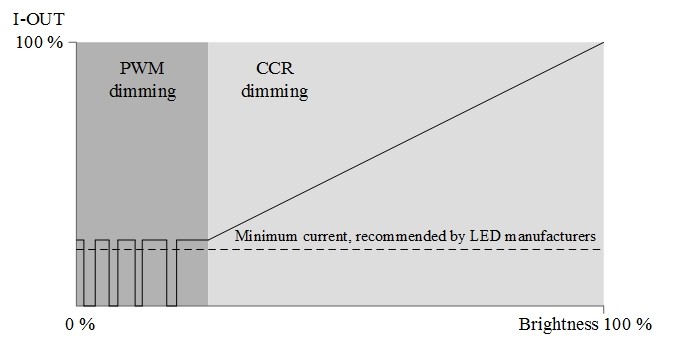One of our key achievements is TruePower technology, which is used in all our luminaires. TruePower is a hardware-software complex, which is a symbiosis of unique LED drivers and a unique controller, thanks to the joint work of which a precise current is provided for the LED chain, and its level is regulated within a wide range by the so-called "analog" method, i.e. without the help of PWM. Thus, if the maximum driver current is 2000 mA, and you set the brightness in the control program to 80%, then the LED chain will receive a current of 1600 mA. If you set the brightness to 20%, the LED chain will have a current of 400 mA, and so on.
TruePower regulates the current by "analog" control from the maximum to the minimum recommended by the LED manufacturer in the technical documentation. This method of management of the current is illustrated by the following diagram:

If it is necessary to reduce the brightness of the LEDs even more than the "analog" method allows, TruePower uses high-frequency PWM with a frequency of 3200 Hz. This frequency is not only unattainable for the vast majority of aquarium controllers, but also for professional lighting systems. For example, the widely used PWM-controller, made by NXP Semiconductors PCA9685 can provide a PWM frequency of no more than 1500 Hz.
We would like to emphasize that TruePower technology is implemented with the use of drivers instead of linear current converters.
For the sake of brevity, we will use the well-known English-language abbreviation LDO to denote linear converters. The drivers used in TruePower have an efficiency of 80 to 97% depending on the length of the LED chain. At the same time, LDOs have an efficiency of 70 to 90%. That is, the drivers, compared to LDO, can save about 10% of energy. Since even good LEDs emit about 50% of their energy consumption in the form of heat, and the losses on the LDO are counted relative to the total energy consumption of the luminaire, the heat generated by the LEDs will increase the amount of heat, generated by the luminaire, by about 20%.
We will consider the impact of this on a practical example. Let's take two identical luminaires, the only difference being that the former uses TruePower technology and the latter uses LDO. Let's assume that the heatsink of the first luminaire has heated up in relation to the ambient temperature by 30 C. Thus the second luminaire will heat up to 36 C. This difference will make you resort to a larger heatsink or will lead to a noticeable reduction of the lifespan of the LEDs if the heatsink remains the same size.
Let us consider what practical advantages, unattainable for traditional brightness control systems with the help of archaic PWM, are provided by the TruePower technology.